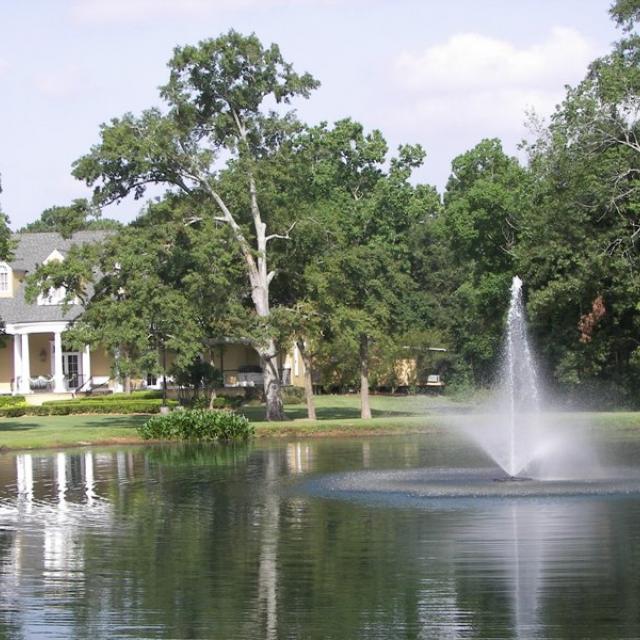The best way to find a solution to your water quality problems is to obtain a better understanding of the components that have an impact on the delicate balance of a pond’s ecosytem.

A pond will deteriorate if the level of dissolved oxygen is insufficient to meet the needs of the plants, fish and other organisms. Fish as well as bottom dwelling organisms will be prone to sickness or may even die. This loss greatly reduces the pond’s self-cleansing capability. For the purpose of oxygenating or introducing oxygen into a pond, a pond aerator is useful. Aeration provides the pond with the oxygen content required for the fish, plants and other organisms. Pond aerators are also silent, reliable and efficient. During warm weather conditions, a pond aerator can supply the oxygen needed in the pond. During the winter, a pond aerator not only supplies the pond with oxygen, but also creates water movement at the surface which protects that area of the pond from the cold. Through that opening in the snow, fresh oxygen can enter the pond, while allowing for the release of the toxic gases produced by the decomposition of rotting organisms.
There are two types of pond aerators.
There is the fountain aerator. There is also the diffused pond aerator. From an aesthetic point of view, the most popular aerator of the two is the fountain aerator. Fountains splash water onto the surface of the pond. That helps control algae growing on the surface. The only disadvantage is that fountain aerators can only aerate shallow ponds. Fountain aerators cannot aerate the bottom of deep ponds.
In order to aerate deep ponds, diffused aerators are the best type to use. The reason is that the air diffusers of diffused aerators are installed at the bottom of the deep pond, which is why they are also called lake bed aerators. They maximise pond aeration because the aeration process begins at the bottom and moves upwards towards the surface, regardless of the depth of the pond. When the diffused air rises to the surface, oxygen is dissolved throughout the pond. Diffused aerators not only aerate the pond in its entirety, they are also more economical because less energy is used to push air through the air diffusers.
Diffused aeration systems have 3 main components - the aeration compressor, the pond aeration pipe or tubing and the aeration diffuser. The pond aeration compressor is the device that sits on the edge of the pond while it pumps air into the pond aeration pipe and into the air diffuser located at the bottom of the pond. The air will then rush out of the aeration diffuser, which is strategically positioned at the bottom of the pond, sending thousands of tiny bubbles to the surface at an average speed of 30 cm (1 foot), thus providing the pond with the vital oxygen it needs. These bubbles not only transfer water from the bottom to the top, they also help circulate and de-stratify the pond. They also replenish the water with oxygen so that aerobic bacteria can remove toxic gases, such as ammonia and hydrogen sulphide, from the water. The bubbles also create ripples on the surface of the pond. The ripples deflect the sun’s rays, preventing sunlight from reaching the bottom of the pond. Without sunlight, algae will not grow on the bottom of the pond.
There are 3 factors which affect the efficiency of diffused aerators – the size of the bubbles, the depth of the pond and the placement of the air diffuser.
The system is more efficient if the size of the bubbles is reduced. This is because smaller bubbles can remain in the water longer than larger bubbles. Consequently the bubbles cover a larger area when dispersed, and while rising to the surface.
The rising of the bubbles to the surface of the pond can move a very large amount of water. It has been calculated that a diffused aerator can move 2267.96 to 3628.74 kilos (5,000 to 8,000 Lbs) of water per hour. For this reason, water circulation increases as the depth of the pond increases.
The air diffuser must be placed in a strategic position for the system to be effective. The problem is that ponds are different. It would be a good idea to call in a specialist to inspect the pond and determine where the air diffuser should be positioned so that the system can not only be effective, but also economically efficient.
Pond aerators are designed to operate continuously throughout the day and night. These devices require very little maintenance. What has to be done to keep the device fully operational is to clean the air filter periodically and replace the diaphragm as well as the watertight seal. Hydrochloric acid or chlorine can be used on pond aerators to keep them operating as if they had just come off the assembly line.
In conclusion, balance is critical to the aquatic ecosystem, and without it you pond or lake will suffer. There are many steps that can prevent an imbalance from occurring, and knowing the causes will assist in determining the best solution for your application. This could involve proper pond construction chemical applications, and the addition of oxygen through aeration systems and devices.
